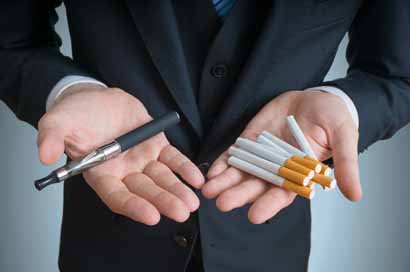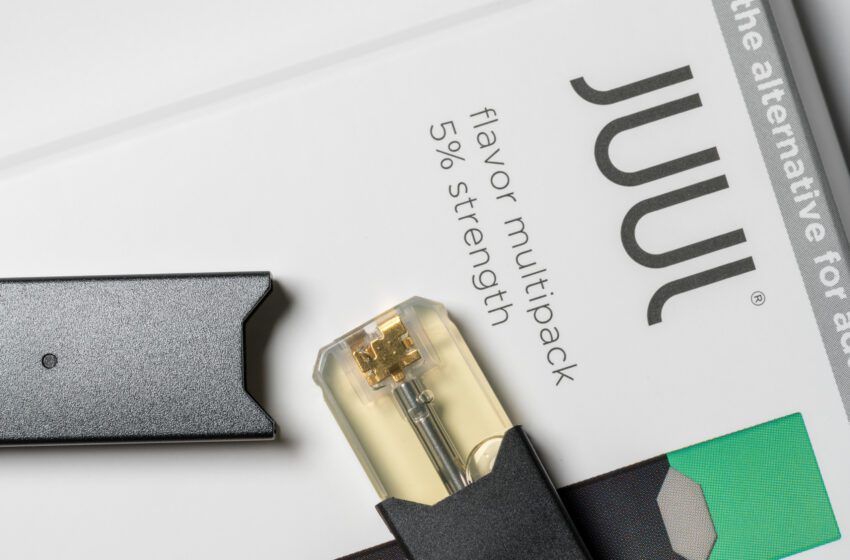Hawaiians on the Big Island are falling in love with Black Lava Vape.
By Timothy S. Donahue
Vapor is hot on the island of Hawaii. The largest island of the U.S. state of Hawaii has seen a boom in vaping over the past few years. Black Lava Vape (BLV), which has the largest vape shops on the island of Hawaii, has also seen rapid growth at its two current locations. It’s needed too. While Hawaii has smoking rates well below the national average, according to the U.S. Centers for Disease Control and Prevention, smokers still made up 13.1 percent of the state’s nearly 1.43 million adult residents in 2016. Nationally, the rate was 17.1 percent.
In order to help further reduce smoking rates, Sean Anderson opened the flagship BLV store in mid-2013 in the town of Kailua-Kona on Hawaii’s Big Island. Today, BLV has outgrown its retail footprint in Kailua-Kona three times and is now in its fourth location in the town of about 12,000 residents on the island’s west coast. “We expanded after the first six months. Our growth has happened quickly,” says Anderson. “We saw a bit of leveling off this year, but our first year we probably doubled our growth, and we did it again in the second year. We are still growing, just not as quickly.”
The shop has done well—so well that in 2017, Anderson opened a second store in Waimea, a town of about 7,000 residents 40 miles north of Kailua-Kona. “The vaping community here is growing quickly,” says Anderson. “This has helped us grow as we see more and more adult smokers convert to vaping. As a former smoker, I know firsthand how vaping can save lives.”
On May 3, 2018, things started to look less lively. The Kilauea volcano erupted dramatically several hours after a magnitude 5.0 earthquake struck the Big Island. It added to a busy day for residents, who were already grappling with five separate eruptions from two fissures on the volcano, according to news reports. Tourism on the island of Hawaii slowed to a near crawl, if anything, according to Patsy Anderson, Sean’s mother and a part owner of BLV. Hawaii typically averages about 1.75 million visitors per year, according to www.govisithawaii.com.
“The volcano going off had a big impact,” said Patsy. “Our customers are mainly locals who count on us, and tourism was falling off, and it took a long time for everyone to get back on their feet. Locals had a hard time after the eruption. We have a heavy tourist clientele too—probably around 70 percent of the tourists that visit the island looking for vapor products shop here. There is only one other vape shop in Kona, and then some gas stations sell limited vapor products too. We also see a lot of the cruise ship staff and vacationers who vape stop by to check us out for new batteries [and] liquid or people [who] have also had their vaporizers taken away by airline security. The volcano put a hold on all that business for a few months. Hawaiians are strong though; we pulled through.”
The idea for BLV began more than a decade ago while Sean was living in California and smoking traditional cigarettes, which he quit by using dip tobacco. He saw someone vaping and quickly became interested in what he thought “was just a fad.” The more he learned about the new products, the more interested he became, and soon he used vapor to quit traditional tobacco products altogether.
Then he converted his brother, also a smoker, to a vaper. It wasn’t long after that when he realized he wanted to become a part of the potentially lifesaving industry. “I thought it was just a gimmick at first. Then, around Christmas of 2011, after I got my brother started vaping, I realized that I was growing tired of the corporate environment I was working in,” says Sean. “I lived in Hawaii from the age of four until about 11 and the place has always been very close to my heart. Driving around [Los Angeles] looking for a vape shop one day with my brother, it just clicked. There were probably not many vape shops in Hawaii. I Googled it and there wasn’t, other than Volcano [eCigs] vape shops on Oahu island.”
That’s when Sean called Patsy. He told her he wanted to open a vape shop back in Kailua-Kona, where the family had lived so many years before. “When he first brought it up, he had a great job. I thought this would be a huge mistake,” says Patsy. She thought he should discuss it with his dad, Bob Anderson, who is now co-owner of BLV. “He told his dad, and, surprise to me, Bob thought it was a great idea.”
Bob had worked construction on the island in the mid-1980s and always wanted to go back. He and Sean decided to go to Kailua-Kona and see if the plan was viable. “We went to Kona, and there was a Volcano [eCigs] kiosk in the mall in Hilo [a town of over 40,000 residents about 80 miles east of Kona on the other side of the Big Island], and that was it,” says Bob. “I did some research, and I really thought this was a good idea. We were all-in at that point. We got a mailbox in Kona and went back to California to start planning out the adventure.”
Then it happened. The Andersons opened the first BLV in June 2013. “My dad invested a lot of money with me. We didn’t have a clue about running a business or how to get the product, and I only had a little business experience,” says Sean. “But I had a real desire and ambition to do this. I knew it was a great business opportunity, so I needed to learn quickly to make it work.”
The reaction from the local community in Kailua-Kona was positive. The store quickly expanded. Soon, the Andersons saw the need for another shop and opened BLV’s Waimea location in 2017. That’s when things got interesting, according to Sean. The Waimea community didn’t initially embrace its new vapor shop. By its third month, the community had planned a town meeting to discuss the new business.
SMALL TOWN, BIG ISSUE
Much like the mainland U.S., Hawaii has some issues with vaping. In early 2018, the Waimea Community Association (WCA) held a meeting to discuss the growing number of vapers in the small town. The meeting was in response to the presence of BLV. Residents at the WCA meeting discussed concerns over vaping, such as health issues, addiction and whether vaping could lead nonsmokers to smoking traditional cigarettes.
There was the typical talk of diacetyl and the potential for popcorn lung. Formaldehyde was brought up several times too, according to Sean. These are age-old industry arguments with simple answers. Most liquid companies don’t use diacetyl, and no one vapes at high enough temperatures to create any significant levels of formaldehyde, according to numerous studies. However, it seems the general public still does not understand this, Sean explains.
During the meeting, residents also expressed concern over BLV’s proximity to a school in Waimea. During the meeting, Sean quickly questioned why his vape shop’s location was concerning when a convenience store selling alcohol, tobacco and vapor products is located even closer to the school than BLV. Sean says he was surprised by the meeting. He didn’t get this type of negative feedback when he first opened the Kailua-Kona location. “It was disheartening,” he said. “It seemed the more adult smokers we converted, the bigger these issues became.”
It is concerning. After all, Hawaii has some of the strictest anti-vaping laws in the country. Restrictions on public smoking also apply to vaping, and you must be 21 to purchase vapor products. Hawaii was the first U.S. state to raise the legal smoking age to 21, which went into effect on Jan. 1, 2018. For the last several years, the state’s legislature has tried to pass bills like S.B. 2304, which would have prohibited the sale of any tobacco or vapor products within 500 feet of any school or public playground, and S.B. 2654 that called for up to an 80 percent tax on e-liquids and the ban of all online sales.
“When they started regulating, Sean went to Honolulu to testify numerous times. We have signed so many petitions, and we have managed to table nearly every attempt,” says Patsy. “This vape community has stuck together through everything. We had to get a license last year, but all tobacco sellers did. We have been fortunate in that the vaping community has been really supportive in this state.” While defeated in 2018, it is expected these bills will reappear in 2019.
The meeting in Waimea, however, was mostly based on another concern about the vapor industry that is growing across all the state’s islands and other U.S. states as well. According to a Hawaii Public Radio story from September 2018, Sally Ancheta, the Hawaii island coordinator for the state’s Tobacco Free Coalition, the state has a significant youth vaping problem—especially on the Big Island.
“Forty-nine percent of our kids are trying e-cigarettes at the high school level, about 35 percent of our middle school students—a daily use rate of 34 percent of our high school students. This is Hawaii County. At the state level, about 27 percent of high school students are trying these devices. The U.S. national high school rate, it’s about 20 percent,” she stated. Ancheta goes on to say that multiple issues factor into why Hawaii’s youth rates are so high. “Our youth influence each other very well. There is not a big perception or an outrage that [vapor] is bad. So, I think [there are] no boundaries, even for families, somebody older than 21 to provide this to somebody under 21.”
Sean says that the numbers do matter. Youth uptake is a concern that should be addressed. He can also only regulate who he and his associates sell the products to, and as Ancheta suggests, it’s difficult to stop someone of age from buying vapor products for teens. That is why BLV is doing what it can to make sure its salespeople only sell to adults of legal age, according to Sean.
“The islands have numerous adult smokers and those are the only potential clients we seek,” he said. “Our mission is to help people quit smoking through a safer alternative. If they can then wean themselves off nicotine through lowering the nicotine levels in their e-juice, we applaud that success. I’m OK with losing customers because people are quitting. It makes us proud to know we are saving lives.”
LIVING ALOHA
The BLV shops carry more than 5,000 stock-keeping units. Sean says he tries to stock numerous coils, even for tanks he doesn’t sell because he serves so many tourists on the island. The shop also stocks about 40 brands of e-liquid with different flavors and nicotine levels. Some of the popular products are Smok hardware and Naked e-liquids. Sean says most of BLV’s inventory comes from customer requests and employee recommendations.
“Our employees are very knowledgeable. I learn from them all the time. They are much more knowledgeable about the industry than me, especially our general manager, Joe Sarabia. He has been with us since the beginning,” says Sean. “When we started, people would want certain brands, and then it became specific flavors of certain brands. Now it’s all over the place.”
BLV currently has nine employees, and Bob says everyone is like a member of the family. “We pay our employees well, and we have very little turnover,” he says. “It’s a fun environment, and we encourage everyone to dress how they want and be comfortable. It’s a very Hawaiian type of vibe. After all, it’s expensive to live here and lots of people have to work two or three jobs.”
A major challenge for BLV, according to Sean, is just getting merchandise to the island in a timely fashion. He says that everything costs a few dollars more in Hawaii just because of the cost to get merchandise shipped over. “That also means we are competing harder against online sales. For the companies on the Mainland, for the most part, their customers don’t pay any shipping at all. It is insanely challenging to keep up with that,” he says. “We hope that our personal service and extensive product line set us apart.”
During Vapor Voice’s December 2018 visit to the Big Island, the news of youths vaping Juul Labs products was being broadcast by numerous national news outlets. Sean says he was disturbed by how Juul Labs handled the situation. Then, when Juul Labs sold a minority stake to Altria, the largest U.S. tobacco company, he decided he wanted to do something.
“Juul has already put a stain on the industry with the whole youth vaping issue, and now it’s a tobacco company. I don’t want to sell their stuff, and I have been getting a lot of the same response from other vape shops on the other islands,” says Sean. Therefore, he is trying to start a coalition of Hawaiian vape shops to agree to refuse to sell Juul products. “I started that today—a business-to-business ban—if the vape shops stop selling Juul that would be good for the industry. We don’t want to be a part of all of the negativity the Juul brand brings.”
Federal regulation is also a concern for Sean. He says the U.S. Food and Drug Administration’s (FDA) view of vapor is overreaching. He sees the regulatory agency as handpicking certain studies instead of looking at the bigger picture. “The U.K. is looking at vaping very differently. They have some strange regulations, for example tanks and e-liquid bottle sizes, but they want people to switch because they understand vaping is safer. I can’t understand why the FDA is taking the completely opposite approach.”
Sean says he will keep pushing forward. The BLV team knows it is helping to make Hawaii healthier. Sean says the family is planning on opening more stores and saving more lives (depending on what happens with FDA regulation, of course). In 2019, BLV will open a third shop in Pahoa, a town 20 miles south of Hilo. In 2020, BLV will open a location in Waikoloa, a village between Kailua-Kona and Waimea.
“We are also looking at possibly expanding to Kauai island [about 300 miles away from the Big Island on the other side of the Hawaiian archipelago],” he says. “Maybe even Maui [the next major island closest to Hawaii island]. We just want to help Hawaiians quit smoking. That’s our aloha, meaning it’s our love, peace and compassion. It’s a guideline for how we should live.”








